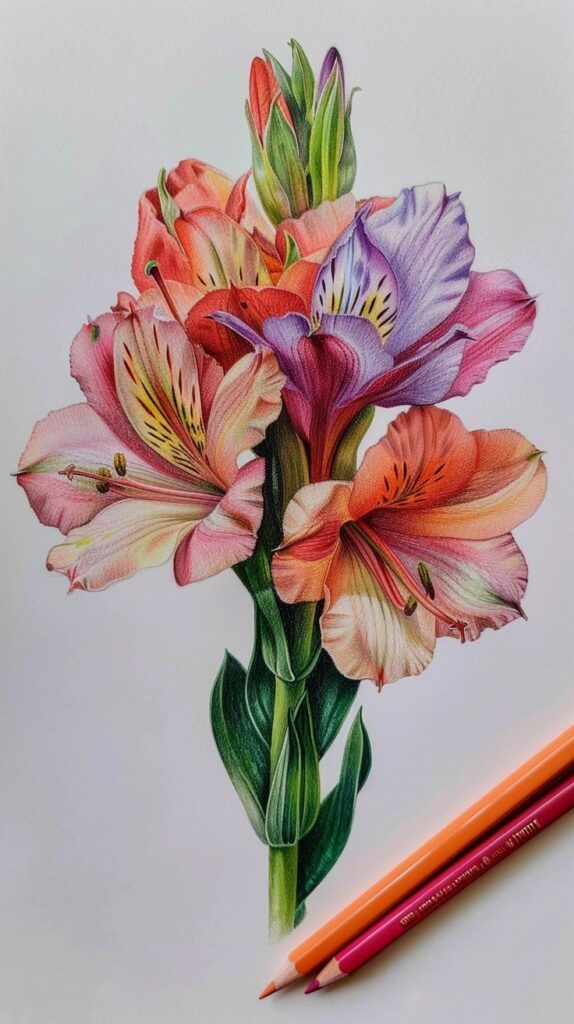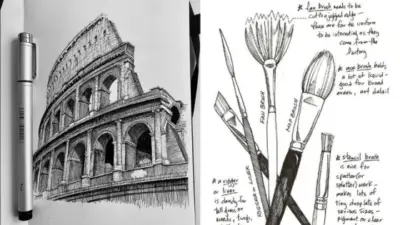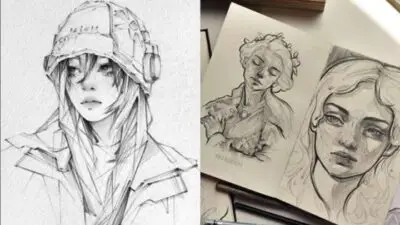Colored pencil drawing is an accessible and versatile art form that many artists are increasingly exploring. With the ability to produce works ranging from photorealism to whimsical abstractions, colored pencils offer a world of possibilities for expressing your creativity. Mastery in colored pencil art begins with understanding the fundamentals and selecting the appropriate materials, which set the foundation for creating captivating pieces.
When starting with colored pencil drawing, choosing the right materials is crucial. From selecting high-quality pencils to picking the right paper, every choice impacts your artwork’s final look. Learning different techniques will allow you to depict various subjects effectively, whether it’s the delicate texture of a flower petal or the shimmering surface of water.
Exploring advanced techniques and tips can refine your skills further, helping you achieve stunning effects and intricate details. Observing and learning from established artists can provide invaluable insights and inspire new ideas for your creations.
Key Takeaways
- Understanding fundamental techniques is essential for colored pencil drawing.
- High-quality materials significantly impact the artwork’s final appearance.
- Learning from experienced artists can provide useful insights and inspiration.


Choosing the Right Materials
Selecting the right tools for colored pencil drawing can significantly influence your artwork’s quality. The focus should be on understanding which colored pencils, drawing paper, and additional art supplies are best suited for your needs.
Types of Colored Pencils
Colored pencils vary in terms of pigment quality, binder type, and overall durability. Consider whether oil-based or wax-based pencils suit your style. Oil-based options like Faber-Castell Polychromos enable easy layer building, while wax-based pencils such as Prismacolor Premier deliver smooth applications. Lightfastness is crucial as it determines how long the colors will last without fading. Make sure to check the lightfast rating of each pencil.
Selecting Drawing Paper
The choice of drawing paper affects how the pencil colors appear and adhere. Look for paper with a smooth or slightly textured surface, depending on whether you want fine lines or more texture for added depth. Strathmore and Canson offer reputable options for colored pencil work. Additionally, consider the paper’s weight; a heavier paper (at least 90-100 lb) will withstand multiple layers of color and prevent warping. Acid-free paper ensures longevity, maintaining the integrity of your art over time.
Additional Art Supplies
Beyond pencils and paper, several art supplies can enhance your work. Blenders and burnishers smooth out colors and improve the overall finish. Erasers, particularly kneaded and hard plastic types, help correct mistakes without damaging paper. A sharpener that maintains the pencil tip without excessive breakage is essential. Some artists incorporate mixed media tools, such as gouache or watercolor, to enrich their colored pencil pieces. Lastly, storage solutions like pencil cases or racks keep supplies organized and protected from damage or loss.


Fundamentals of Colored Pencil Drawing
Mastering colored pencil drawing requires an appreciation for both technique and composition. You will learn how careful planning contributes to the composition of your artwork, as well as methods for layering and developing detailed drawings using specific drawing techniques.
Understanding Composition
Composition is key to guiding the viewer’s eye and conveying the desired mood in your artwork. It involves organizing elements within your drawing effectively. Consider using techniques like the rule of thirds, which helps distribute attention across your piece. Focus on the balance between positive and negative space, ensuring that your main subject doesn’t overcrowd the drawing.
Experiment with focal points to direct emphasis and highlight areas of importance. Study the work of established artists to understand how they balance color and shape within their compositions. Simple sketches can help you plan compositions before executing detailed work.
Drawing Techniques
Effective colored pencil drawing relies on mastering specific techniques. Layering is crucial, allowing for rich color depth and subtle gradations. Start with light layers and gradually build up to achieve the desired intensity. Blending further enhances this by softening transitions between colors. Techniques like hatching and cross-hatching aid in creating texture and volume.
Use burnishing to create a glossy, finished look by applying heavy pressure over layered colors. Practice different strokes such as stippling and the back-and-forth stroke to vary the surface texture. A skilled artist combines these techniques to add detail, bringing out the depth and realism in their drawings. Each method opens new possibilities for detailed and expressive works.


Drawing Different Subjects
Colored pencil drawing offers the flexibility to capture various subjects, each with unique techniques and considerations. From the intricate details of animals to the broad strokes of landscapes, understanding how to approach each subject can greatly enhance your artwork.
Rendering Animals and Pets
When drawing animals and pets, focus on capturing their texture and personality. Fur and feathers can be represented using light, short strokes to mimic the natural patterns. Use layers to add depth and dimension. Cats and dogs have different fur textures; for cats, employ soft, gentle strokes, while for dogs, alter between short and longer strokes.
Pay attention to the eyes as they are crucial in conveying emotion. Bright highlights can give pets a lively and realistic appearance. Consider the subject’s natural habitat or background. For instance, a shaded deck might complement a sleeping dog or a sunlit porch for a lounging cat.
Creating Striking Landscapes
Landscapes offer a broad canvas for exploring color and texture. Start by defining the horizon and key elements like trees and water bodies. Use layering techniques to create depth, beginning with light skies and progressively darker elements in the foreground.
For grass and foliage, varying green hues with subtle shades can make the scene more dynamic. Techniques such as blending and burnishing can produce smoother transitions, especially in skies or water. When drawing backgrounds, consider how light interacts with elements; a sunset may require blending warm tones with cool shadows for a striking effect.
Capturing the Essence of Portraits
Portraits in colored pencil require a keen eye for detail, especially in rendering skin tones and facial expressions. Use a combination of warm and cool colors to create realistic skin tones. Building up layers gradually can result in a more natural look.
Focus on the facial features, as these are crucial for likeness and emotion. The eyes, in particular, can be enhanced with reflections and highlights. Consider the background subtly; a simple gradient or lightly detailed setting can ensure the portrait remains the focal point. Balancing contrast and shadow adds depth, aiding in establishing mood and expression.


Advanced Techniques and Tips
In colored pencil drawing, mastering different techniques can significantly elevate your artwork. Effective use of layering and blending can create depth, while thoughtful backgrounds enhance the composition.
Mastering Layering and Blending
Layering is essential for building vivid and detailed drawings. Start by applying light pressure to your pencil, slowly building up colors. Use multiple layers to achieve a rich, nuanced result. Blending is crucial for smoothing transitions between colors. Utilize tools like blending stumps or even a light-colored pencil for seamless integration.
When working on more complex pieces, gradually adjust layer intensity. This approach ensures depth and dimensionality. Experimentation with pressure and pencil angle can yield various textures, enriching the drawing’s complexity.
Enhancing Complexity with Backgrounds
Backgrounds play a pivotal role in setting the stage for your artwork. Instead of leaving them plain, use them to add narrative and contrast. Choose colors that complement the main subject while also introducing new textures.
Employ drawing techniques like cross-hatching or stippling to give more depth. Integrating subtle layers in the background can enhance sophistication without overshadowing the focal point. Think of the background as part of the story you’re telling, guiding the viewer’s eye through the composition naturally.


Learning from Example
Studying colored pencil artists can greatly enhance your understanding of techniques and styles. Exploring tutorials provides insights into blending, shading, and color palette decisions. Your skills can improve by learning from the experiences of others.
Exploring Tutorials and Demonstrations
To advance your colored pencil drawing skills, seek out tutorials that focus on specific techniques. Many artists share their methods through step-by-step guides and video demonstrations. By following along, you can grasp how to layer colors effectively, achieve smooth gradients, and create depth in your work.
Experiment with projects like drawing fruits, such as cherries, to practice choosing appropriate color palettes and applying foundational techniques. Engaging with these resources encourages experimentation and boosts your confidence in handling colored pencils. Engage with diverse perspectives to enrich your artistic journey.
- 2.2Kshares
- Facebook0
- Pinterest2.2K
- Twitter0



